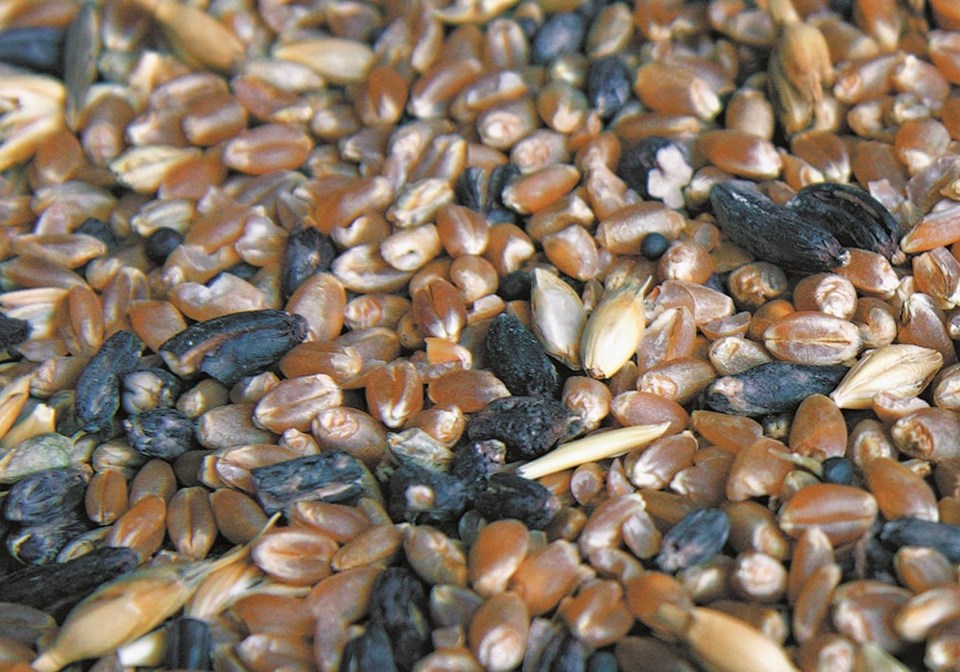WESTERN PRODUCER — Cattle producers in Western Canada should pay more attention to ergot levels in their feed after new research found that previously recommended levels should be lower.
Research conducted by Dr. Gabriel Ribeiro and others at the University of Saskatchewan has led to recommendations that cattle not consume feed with more than one part per million of total ergot alkaloids.
That compares to Canadian Food Inspection Agency recommendations that say two to three p.p.m. of total ergot alkaloids are acceptable in feed.
Ribeiro and his research partners, including Dr. Kim Stanford at the University of Lethbridge and Dr. Karen Schwarzkopf from Agriculture Canada, conducted extensive research on how cattle react to different levels of ergot-infected feed.
Ergot is a plant disease caused by Claviceps purpurea fungus. Ergot bodies grow in place of seed in the heads of some grasses and cereals.
It has devastating effects on cattle, including suppression of feed intake and loss of gain at lower levels. At higher levels, it affects the circulatory system and can cause loss of hoofs and ears through gangrene.
“People think (ruminants) can take more (mycotoxin like ergot) than other livestock species, but the microbes in the rumen can’t change the ergot alkaloids in the rumen,” said Ribeiro, an assistant professor and Saskatchewan Beef Industry Chair at the U of S.
“Cattle can get pretty bad symptoms of toxicity when they have some in the diet.”
The researchers have completed several studies over the past few years that led them to the new recommendation.
The studies included one that found ergot had little effect on microbes and fermentation in the rumen.
A larger study at a feedlot looked at both background and finishing cattle and fed them up to the limits that the CFIA would suggest — three p.p.m. They looked at the reaction of cattle fed diets of 0.75 p.p.m., 1.5 p.p.m. and three p.p.m. Many parameters were monitored, including a full blood panel, temperature, lameness, feed intake, gain and carcass data after slaughter.
When the animals were fed above 1.5 and three p.p.m., they had significantly reduced feed intake and body weight gain, which resulted in lighter carcasses with less fat in the meat after slaughter.
As well, the researchers observed significant increases in heat stress, especially among the cattle fed three p.p.m. and when temperatures rose higher than 20C.
“We have seen really bad signs of heat stress with higher levels,” Ribeiro said.
They included panting, open mouth, extended tongue, heavy breathing and foaming at the mouth. The symptoms were severe enough that the cattle weren’t fed the ergot-contaminated feed if the temperature didn’t drop below 20 C overnight.
The cattle would do whatever they could to reduce the heat, including hanging around water troughs, drinking more water, playing and splashing in the water to get themselves wet and making mud puddles to lie in.
High levels of ergot feed consumption affect the circulatory system, including blood vessels and basal constrictions that prevent blood flow to the extremities.
Another clinical sign was that cattle didn’t lose their winter coats and therefore had a shaggy, unkempt appearance.
“Sometimes people see times of heat stress and don’t think it was ergot,” said Ribeiro.
The researchers also looked at the impact of limited access to ergot-infected feed.
“Feedlots go very quickly through grain, so they don’t constantly have grain contaminated,” said Ribeiro.
However, the scientists couldn’t find research that had examined intermittent feeding of high-mycotoxin feed.
The researchers looked at cattle that were fed a two p.p.m. ergot alkaloid diet and then were taken off the diet for one or two weeks. They found there was still an economically damaging impact on the animals.
The researchers are next looking at mycotoxin binders to see if they have enough effect on ergot. Ribeiro said earlier binders didn’t work well on ergot, but companies claim new binders should help. The researchers want to see for themselves.
Pelleting contaminated feed at high temperatures also hasn’t been shown to affect contamination.
Blending high ergot-contaminated feed is the best way to manage it, but Ribeiro recommends making sure levels are below one p.p.m.
No on-site rapid tests are available that show levels of ergot contamination. Samples have to be sent to a laboratory for assessment using high-performance liquid chromatography.
Ribeiro gave the example of a farmer who was away for a few days and told staff to blend ergot-infected feed at 10 percent of the total ration, without knowing how bad the problem was in the contaminated portion. The producer lost 10 cattle.
“It’s a problem when you don’t know what you are feeding, even if it’s in very low quantities,” he said.
Beef producers in many parts of the Prairies are struggling to find enough feed after a dry summer reduced forage crops.
Ribeiro advised caution when considering products such as grain fines as an alternative feed because mycotoxins like ergot can be concentrated. Test to make sure ergot levels are within recommendations.
Rye is considered the biggest ergot risk, but barley and increasingly wheat are also concerns, so producers should keep that in mind when considering feed wheat.




